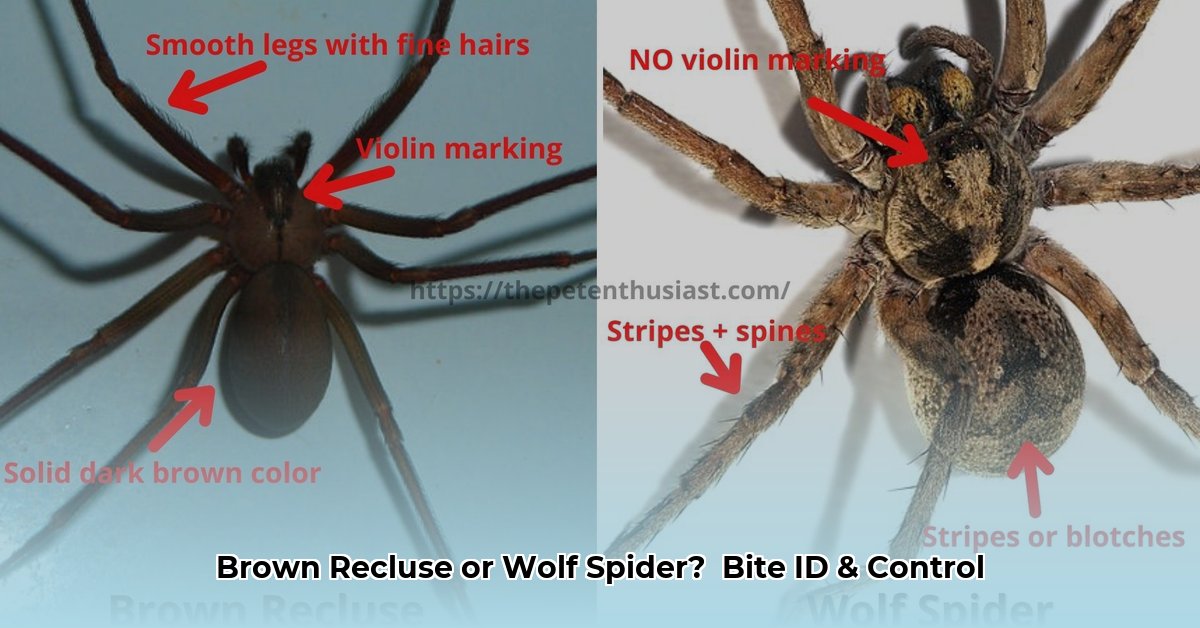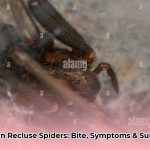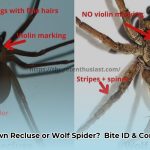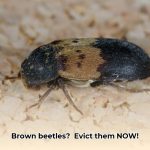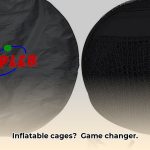This guide provides essential information for identifying and differentiating between brown recluse and wolf spiders, understanding the potential risks of their bites, and implementing effective control measures.
Recognizing the Recluse and the Wolf
Mistaking harmless spiders for the brown recluse is common. This section clarifies the key differences between these two species.
Size and Shape
- Brown Recluse: Reaches a maximum size of about ¾ inch (about the size of a U.S. penny). They have a slender, smooth body.
- Wolf Spider: Can grow significantly larger, sometimes exceeding an inch in length (larger than a quarter). Their bodies are robust and noticeably hairy.
Markings and Eyes
- Brown Recluse: Look for the characteristic “violin” marking on its back (cephalothorax). Note that this marking can be faint or vary slightly. Crucially, they have six eyes arranged in three pairs.
- Wolf Spider: Lacks the violin marking. Instead, wolf spiders typically exhibit mottled gray, brown, or black camouflage patterns. They have eight eyes arranged in three rows: a top row of four small eyes, two prominent large eyes in the middle row, and two medium-sized eyes below.
Webs and Habitat
- Brown Recluse: True to their name, they prefer dark, undisturbed areas like closets, storage boxes, and woodpiles. Their webs are messy and irregular, serving more as retreats than hunting tools.
- Wolf Spider: Active hunters that do not build webs. They roam freely, often found outdoors in grassy or leafy areas, or indoors near floor level.
Bite Identification and Treatment
While neither spider is aggressive, understanding bite symptoms and appropriate treatments is crucial.
Brown Recluse Bite
- Initial Symptoms: Often painless or with a mild stinging sensation.
- Developing Symptoms: Over several hours, a blister or ulcer may form, potentially turning dark due to necrosis (tissue death). Fever, chills, or nausea may also occur.
- Treatment: Clean the bite with soap and water, apply a cool compress, and elevate the affected area. Seek immediate medical attention, especially if necrosis or systemic symptoms develop. While antivenom isn’t routinely used, a doctor may consider it in severe cases.
Wolf Spider Bite
- Initial Symptoms: Immediate, sharp pain, similar to a bee sting, followed by redness, swelling, and itching. Swollen lymph nodes are possible but rare. Necrosis is extremely uncommon.
- Treatment: Clean the wound, apply a cool compress, elevate the area, and use over-the-counter pain relievers (ibuprofen or acetaminophen) and antihistamines (like Benadryl) as needed. Consult a doctor if symptoms worsen or signs of infection appear.
Spider Control and Prevention
Implementing preventative measures can significantly reduce the risk of spider encounters.
- Declutter and Clean: Regularly clean and declutter your home to eliminate potential hiding places.
- Protective Clothing: Wear gloves when working outdoors in areas where spiders may reside (woodpiles, sheds). Shake out clothing and shoes before wearing them.
- Seal Entry Points: Seal cracks and crevices in your home’s foundation to prevent spiders from entering.
- Professional Pest Control: For persistent infestations, consult a pest control professional for safe and effective insecticide application.
Debunking Spider Myths
- Aggression: Brown recluses are not aggressive and bite only when they feel threatened or trapped.
- Bite Misdiagnosis: Brown recluse bites are often misdiagnosed, particularly outside their native range. Many skin lesions are mistakenly attributed to them when other medical conditions are the likely cause.
- Range: While brown recluses can be found in various habitats within their range (primarily the central and southeastern United States), they are not ubiquitous.
Ongoing Research
Research into spider venom and its effects is ongoing, continually refining our understanding of these creatures. For definitive identification and medical advice, always consult with qualified professionals. Your local health department or a pest control expert can provide region-specific guidance and address your concerns.
- Burning Plastic Smell in House: Causes, Solutions, and Safety Measures - April 8, 2025
- Best Bug Killer for Yard: Effective Pest Control Guide (2024) - April 8, 2025
- Brown Recluse Spider Bites: Identification, Treatment, and Prevention - April 8, 2025
